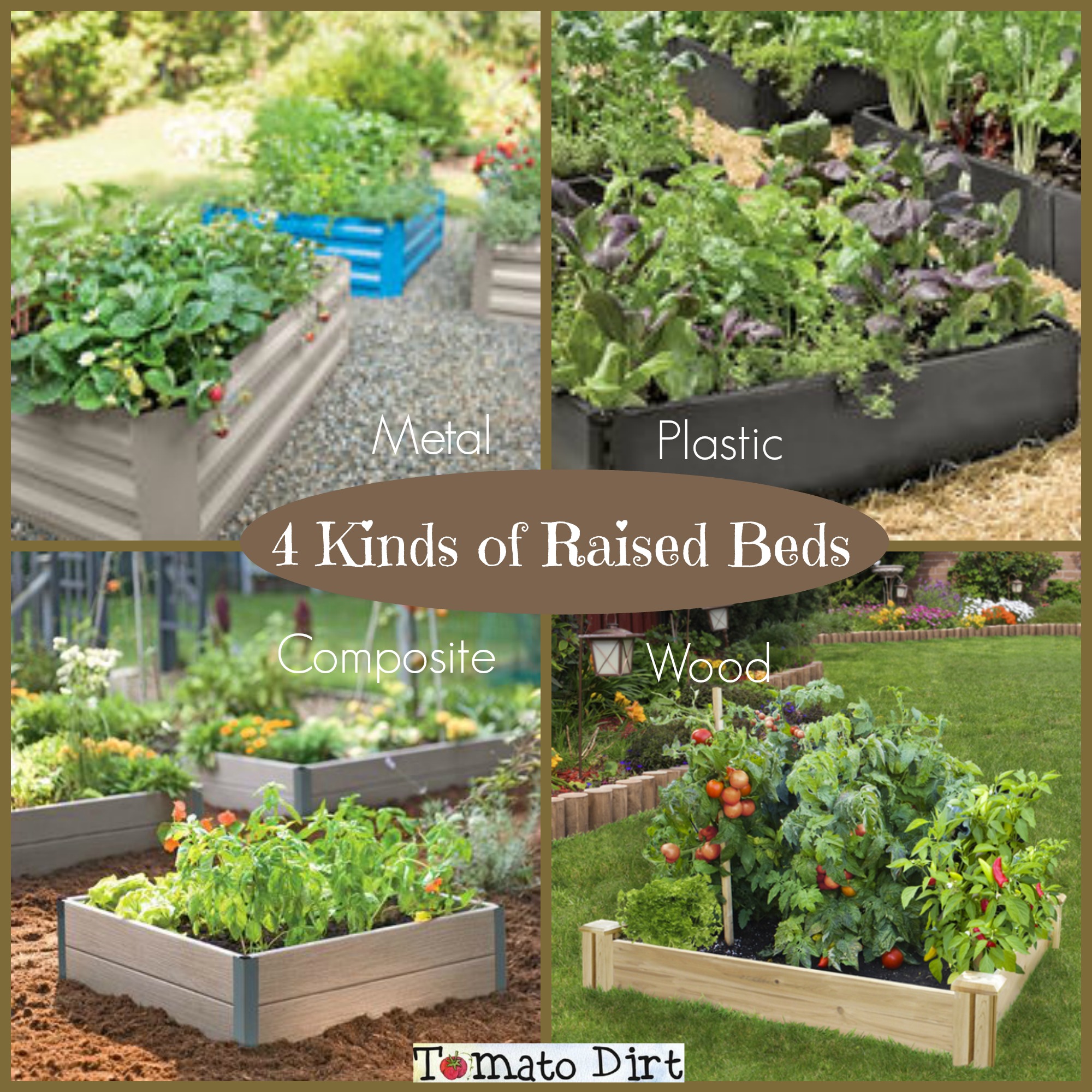FREE: 10 Must-Know Tomato Growing Tips Get The Guide
Read our affiliate disclosure here.
Choose Materials for Your Raised Garden Bed: a Primer
Since 2010, Tomato Dirt has garnered 4.8+ million views, making it the web’s leading online source for growing tomatoes in the home garden. Award-winning writer and Tomato Dirt owner Kathy Widenhouse has helped thousands of home gardeners grow healthier tomatoes. Be one of them when you get Tomato Dirt’s Growing Guide here.
Updated 1.18.25
What materials should you choose for your raised garden bed? This is an important decision.
You want to select an edging material that is long-lasting so you can grow tomatoes year after year.
At the same time, you want the materials to be attractive, since the raised beds will (hopefully) be with you and your landscape a long time.
Here’s the dirt: you can build a raised bed out any material, including landscape blocks, water-filled plastic, or even concrete.
But here are the four most commonly-used materials. And as you’ll see, they are popular with good reason.
Wood
Wood raised beds are considered by many to be the most durable and most attractive option. Two types of wood are most popular for raised beds.
- Cedar: naturally decay-resistant and long-lasting. both white cedar (less expensive, sturdier, but marked by knots) and red cedar (strong but brittle) can last 15-25 years without treatment, even in extreme weather.
- Pine (or fir): less expensive, but lasts 7-12 years.
If you treat wood for your raised garden bed to increase durability, be sure to choose a non-toxic stain or sealant such as Eco Wood Treatment or Cedar Garden Bed Oil. Otherwise, chemicals from the wood treatment can leach into the ground – and your plants – and ultimately into your food. It is for this reason we recommend you do not use railroad ties for your raised garden bed, as they have been treated with creosote and other chemicals.
Advantages to wood: cost, durability, biodegradability, and appearance.
Disadvantages to wood: decay (pine) and maintenance. If left untreated, cedar will turn gray over time.
There's a good selection of cedar raised beds at Burpee and Gardener's Supply.
Recycled Plastic
Recycled plastic raised beds are made from high-density polyethylene (HDPE) plastic, which is extremely durable and non-leaching. The material is recycled from milk jugs. Along with raised beds, the plastic used for other outdoor fixtures such as picnic tables and benches. It can be dyed different colors. In terms of strength, board lengths are not as stable as wood or steel and can bow out more easily when the weight of soil presses against its edges.
Advantages to recycled plastic: long-lasting, environmentally-responsible, easy to wash, low-maintenance.
Disadvantages to recycled plastic: expensive. Can bow or bend.
Recycled Composite
Attractive and long-lasting, new composite materials are an excellent “green” alternative to building raised beds. Composites are a combination of wood fiber and recycled polypropylene. Most gardeners choosing this kind of raised beds do so by buying a kit or pre-cut components. Composites do not rot, splinter, or attract pests. They contain no chemicals that may be harmful to the soil or tomato crop. Keep in mind that the boards are hollow in the centers and can bow or bend with soil’s excess weight.
Advantages to composites: environmentally-sound, long-lasting, and maintenance-free.
Disadvantages to composites: more expensive than wood, plastic, or metal. Can bow or bend. Colors may fade.
Galvanized Metal
Sturdy, galvanized sheet metal does not bow or bend. Since it has proven to be is a superior material for watering troughs and outbuildings, galvanized metal can be a stylish alternative for your raised garden bed in an early-American throw-back look or a more modern twist. Be aware that galvanized metal is treated with zinc, nickel, and bismuth. Over time the surface treatments may corrode and leach into the soil, although at trace levels not considered to be a factor in affecting plant health and chemistry. In fact, zinc has been shown to inhibit fungi growth – a benefit for growing tomatoes.
Metal raised beds are available in kits which can be expensive, but you can also buy materials and make them yourself and save. If you’re a handy do-it-yourselfer, cost-conscious, and and willing to work with corrugated metal (rather than use a kit), then this could be a good choice for you.
Advantages to galvanized metal: strength, maintenance, strength, recyclable, and (according to preference) appearance
Disadvantages to galvanized metal: appearance; assembly (when doing it yourself.)
You can find a terrific selection of raised garden bed at Burpee and Gardener's Supply.
More about Raised Beds for Tomatoes
7 Benefits of Raised Beds for Gardening ...
8 Guidelines for Growing Raised Bed Tomatoes ...
Raised Beds for Tomatoes: the basics you need to know ...
8 Low Cost Raised Garden Beds You Can DIY ...
16 Cost-Saving Tips for Do-It-Yourself Raised Garden Beds ...
What to Put on Bottom of Raised Garden Bed ...
6 Tips for Growing Tomatoes In Raised Garden Beds ...
Starting a Raised Bed Vegetable Garden FAQs ...
Raised Bed ideas on our Pinterest board ...
Return from Materials for Your Raised Garden Bed to Tomato Dirt home
As an Amazon Associate and Rakuten Advertising affiliate I earn from qualifying purchases.
SHARE THIS PAGE:
FREE! 10 Must-Know Tomato Growing Tips: 20-page guide
Get yours here:





New! Comments
Have your say about what you just read! Leave a comment in the box below.